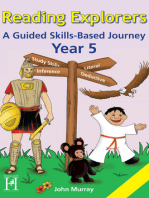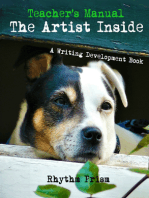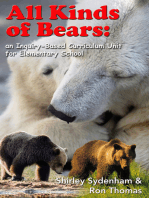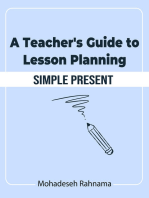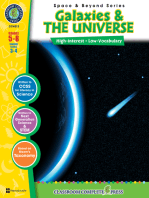STEPP Lesson Plan Form: Colorado State University College of Applied Human Sciences
Uploaded by
api-318005864STEPP Lesson Plan Form: Colorado State University College of Applied Human Sciences
Uploaded by
api-318005864STEPP Lesson Plan Form
Teacher: Holly Beisner
School:
Rocky Mountain High School
Title: Intro to the 1960s
Grade Level: 11/12
Content Area: History Of Rock & Roll
Lesson #1 of 5
Content Standard(s) addressed by this lesson:
(Write Content Standards directly from the standard)
Theme 1: Culture
Theme 2: Time, Continuity, and Change
Theme descriptions can be found at the following website: http://www.socialstudies.org/standards/strands
Understandings: (Big Ideas)
Students will understand the major events taking place in the 1960s. The major events will come from
multiple perspectives including political, musical, environmental and social issues. Students will specifically be
able to relate issues to music and express how music influenced movements or the other way around if
applicable.
Inquiry Questions: (Essential questions relating knowledge at end of the unit of instruction, select applicable
questions from standard)
What are some of the issues going on on the 1960s and how do these issues or movements relate to music?
Evidence Outcomes: (Learning Targets)
Every student will be able to: Explain at least three specific things taking place in the 1960s and how those
events influenced music.
I can: I can explain how music and events in the 1960s are related, using specific examples.
This means: This means I understand that music and events are linked and that many artists, specifically
mainstream artists in the 1960s and 70s, use music as a way to influence people.
Colorado State University College of Applied Human Sciences
Page 1
STEPP Lesson Plan Form
List of Assessments: (Write the number of the learning target associated with each assessment)
*Lecture to establish background on the major events.
*Discussion of the events and explanation to any questions about points of confusion.
Planned Lesson Activities
Name and Purpose of Lesson
Should be a creative title for you and the
students to associate with the activity.
Think of the purpose as the mini-rationale
for what you are trying to accomplish
through this lesson.
Approx. Time and Materials
How long do you expect the activity to
last and what materials will you need?
Anticipatory Set
The hook to grab students attention.
These are actions and statements by the
teacher to relate the experiences of the
students to the objectives of the lesson,
To put students into a receptive frame of
mind.
To focus student attention on the
lesson.
To create an organizing framework
for the ideas, principles, or
information that is to follow
(advanced organizers)
An anticipatory set is used any time a
different activity or new concept is to be
introduced.
Intro the the 1960s the purpose is to show students the link between
music and the movements taking place in the 1960s.
This lesson will take the entire class and students will not need any
materials. All materials will be provided for them on the smart board.
Students will begin class by watching a few short clips of CNNs The
Sixties. This will be the introduction to many of the events that we will
further discuss in class but introduce them in a fun way by showing lots
of live footage of many of the events.
(I cant link this in since it is a Netflix film but parts of it can be found at
the following link)
http://www.cnn.com/shows/the-sixties
Colorado State University College of Applied Human Sciences
Page 2
STEPP Lesson Plan Form
Procedures
(Include a play-by-play account of what
students and teacher will do from the
minute they arrive to the minute they
leave your classroom. Indicate the length
of each segment of the lesson. List actual
minutes.)
Indicate whether each is:
-teacher input
-modeling
-questioning strategies
-guided/unguided:
-whole-class practice
-group practice
-individual practice
-check for understanding
-other
Closure
Those actions or statements by a teacher
that are designed to bring a lesson
presentation to an appropriate conclusion.
Used to help students bring things
together in their own minds, to make
sense out of what has just been taught.
Any Questions? No. OK, lets move on is
not closure. Closure is used:
To cue students to the fact that
they have arrived at an important
point in the lesson or the end of a
lesson.
To help organize student learning
To help form a coherent picture and to
consolidate.
Differentiation
To modify: If the activity is too advanced
for a child, how will you modify it so that
-Attendance
- CNN video (unguided whole group)
-Lecture (teacher input)
- Class discussion/ links to music (modeling, teacher input, guided
group practice)
- Wrap up CNN video for closure (unguided whole group)
For closure of this lesson we will end by returning to the CNN video and
watching more short clips from it that dive deeper into the discussions
that we had after lecturing, continuing to elaborate on the background
and being visually appealing.
The video should meet all of the needs of students that do not have
much background on these issues prior to lecture however during
lecture I will be able to answer any lingering questions that students
Colorado State University College of Applied Human Sciences
Page 3
STEPP Lesson Plan Form
they can be successful?
To extend: If the activity is too easy for a
child, how will you extend it to develop
their emerging skills?
Assessment
How will you know if students met the
learning targets? Write a description of
what you were looking for in each
assessment.
may have about an event/person.
Students will be assessed at the end of class with guided group
questioning where every table group will be required to share out/
answer the learning target question listed above. No group will be able
to repeat anything that the group that went before them did, requiring
every group to say something different.
Colorado State University College of Applied Human Sciences
Page 4
STEPP Lesson Plan Form
Post Lesson Reflection
1. To what extent were lesson objectives achieved? (Utilize
assessment data to justify your level of achievement)
Students overall were able to achieve this lessons learning objectives.
There was a lot of information to take in during this lesson and for
some of the freshman in this class their history classes had not
covered some of this material yet and they struggles to reach it in the
same amount of time as some of the students with more background
knowledge.
2. What changes, omissions, or additions to the lesson would
you make if you were to teach again?
In the future I think that I should group students up by grade and have
them work through the lecture together that way they can rely on each
other for a little explanation of the history as we move through it.
3. What do you envision for the next lesson? (Continued practice,
reteach content, etc.)
The next lesson will start into the beginning of the Beatles career and
begin into 1960s rock and pop music.
Colorado State University College of Applied Human Sciences
Page 5
You might also like
- Art Is Fundamental: Teaching the Elements and Principles of Art in Elementary SchoolFrom EverandArt Is Fundamental: Teaching the Elements and Principles of Art in Elementary School4.5/5 (6)
- Ultimate Driving School Leeds Lessons Handout67% (3)Ultimate Driving School Leeds Lessons Handout50 pages
- Hacking Learning Centers in Grades 6-12: How to Design Small-Group Instruction to Foster Active Learning, Shared Leadership, and Student AccountabilityFrom EverandHacking Learning Centers in Grades 6-12: How to Design Small-Group Instruction to Foster Active Learning, Shared Leadership, and Student Accountability5/5 (4)
- Hacking Questions: 11 Answers That Create a Culture of Inquiry in Your ClassroomFrom EverandHacking Questions: 11 Answers That Create a Culture of Inquiry in Your Classroom5/5 (4)
- Nstp-Cwts Specific Module 2 - Volunteerism100% (2)Nstp-Cwts Specific Module 2 - Volunteerism32 pages
- Powerful Lesson Planning: Every Teacher's Guide to Effective InstructionFrom EverandPowerful Lesson Planning: Every Teacher's Guide to Effective InstructionNo ratings yet
- Republic of The Philippines: Tarlac State University100% (1)Republic of The Philippines: Tarlac State University10 pages
- STEPP Lesson Plan Form: Colorado State University College of Applied Human SciencesNo ratings yetSTEPP Lesson Plan Form: Colorado State University College of Applied Human Sciences5 pages
- STEPP Lesson Plan Form: Content Standard(s) Addressed by This LessonNo ratings yetSTEPP Lesson Plan Form: Content Standard(s) Addressed by This Lesson5 pages
- STEPP Lesson Plan Form: Colorado State University College of Applied Human SciencesNo ratings yetSTEPP Lesson Plan Form: Colorado State University College of Applied Human Sciences5 pages
- STEPP Lesson Plan Form: Colorado State University College of Applied Human SciencesNo ratings yetSTEPP Lesson Plan Form: Colorado State University College of Applied Human Sciences5 pages
- Five D’s of Instructional Design: Empowering Student-Centered Learning Excellence: Unveiling the 5 D's Framework for TransformationFrom EverandFive D’s of Instructional Design: Empowering Student-Centered Learning Excellence: Unveiling the 5 D's Framework for TransformationNo ratings yet
- Blueprint For Thoughtful Lesson Planning: Excavating For Conceptual UnderstandingFrom EverandBlueprint For Thoughtful Lesson Planning: Excavating For Conceptual UnderstandingNo ratings yet
- STEPP Lesson Plan Form: Colorado State University College of Applied Human SciencesNo ratings yetSTEPP Lesson Plan Form: Colorado State University College of Applied Human Sciences5 pages
- The Structured Method of Pedagogy: Effective Teaching in the Era of the New Mission for Public Education in the United StatesFrom EverandThe Structured Method of Pedagogy: Effective Teaching in the Era of the New Mission for Public Education in the United StatesNo ratings yet
- STEPP Lesson Plan Form: Colorado State University College of Applied Human SciencesNo ratings yetSTEPP Lesson Plan Form: Colorado State University College of Applied Human Sciences9 pages
- People Interacting: 150 Activities to Promote Self Awareness, Communication, Social and Problem-Solving SkillsFrom EverandPeople Interacting: 150 Activities to Promote Self Awareness, Communication, Social and Problem-Solving SkillsNo ratings yet
- Transform Your Teaching with Universal Design for Learning: Six Steps to Jumpstart Your PracticeFrom EverandTransform Your Teaching with Universal Design for Learning: Six Steps to Jumpstart Your PracticeNo ratings yet
- Flip Your Classroom, Revised Edition: Reach Every Student in Every Class Every DayFrom EverandFlip Your Classroom, Revised Edition: Reach Every Student in Every Class Every Day4/5 (9)
- Themes for Inclusive Classrooms: Lesson Plans for Every LearnerFrom EverandThemes for Inclusive Classrooms: Lesson Plans for Every LearnerNo ratings yet
- Uncovering Student Ideas in Physical Science, Volume 1: 45 New Force and Motion Assessment ProbesFrom EverandUncovering Student Ideas in Physical Science, Volume 1: 45 New Force and Motion Assessment Probes5/5 (1)
- STEPP Lesson Plan Form: Colorado State University College of Applied Human SciencesNo ratings yetSTEPP Lesson Plan Form: Colorado State University College of Applied Human Sciences5 pages
- You Can Teach This Class - 194 Inspirational Teaching ActivitiesFrom EverandYou Can Teach This Class - 194 Inspirational Teaching ActivitiesNo ratings yet
- STEPP Lesson Plan Form: Colorado State University College of Applied Human SciencesNo ratings yetSTEPP Lesson Plan Form: Colorado State University College of Applied Human Sciences5 pages
- Inquire, Investigate, Integrate!: Making Connections to the K-2 Science Standards and the Common CoreFrom EverandInquire, Investigate, Integrate!: Making Connections to the K-2 Science Standards and the Common CoreNo ratings yet
- Exam Literacy: A guide to doing what works (and not what doesn't) to better prepare students for examsFrom EverandExam Literacy: A guide to doing what works (and not what doesn't) to better prepare students for examsNo ratings yet
- More Behavior Solutions In and Beyond the Inclusive Classroom: A Must-Have for Teachers and Other Educational Professionals!From EverandMore Behavior Solutions In and Beyond the Inclusive Classroom: A Must-Have for Teachers and Other Educational Professionals!No ratings yet
- Small Shifts: Cultivating a Practice of Student-Centered TeachingFrom EverandSmall Shifts: Cultivating a Practice of Student-Centered TeachingNo ratings yet
- Teaching Science in Elem Grades(Bio & Chem)No ratings yetTeaching Science in Elem Grades(Bio & Chem)10 pages
- AY18 Theory of War & Strategy Core CourseNo ratings yetAY18 Theory of War & Strategy Core Course100 pages
- NG-CDF: National Government Constituencies Development Fund100% (1)NG-CDF: National Government Constituencies Development Fund4 pages
- A. Discuss The Different Types of AgentsNo ratings yetA. Discuss The Different Types of Agents4 pages
- Secondary Term 3 2023-24 Exam Timetable Yr 6 To Yr 9No ratings yetSecondary Term 3 2023-24 Exam Timetable Yr 6 To Yr 94 pages
- School INSET Report Template SY 2023 2024No ratings yetSchool INSET Report Template SY 2023 20245 pages
- Education: 24 Topbank Drive, Toronto ON, M9W 7C2 Mobile: 647-760-4558No ratings yetEducation: 24 Topbank Drive, Toronto ON, M9W 7C2 Mobile: 647-760-45583 pages
- A Translation Quality Assessment of Two English Translations of Nazım HikmetNo ratings yetA Translation Quality Assessment of Two English Translations of Nazım Hikmet14 pages
- Curriculum Design in English Language TeachingFrom EverandCurriculum Design in English Language Teaching
- Art Is Fundamental: Teaching the Elements and Principles of Art in Elementary SchoolFrom EverandArt Is Fundamental: Teaching the Elements and Principles of Art in Elementary School
- Reading Explorers Year 4: A Guided Skills-Based JourneyFrom EverandReading Explorers Year 4: A Guided Skills-Based Journey
- Hacking Learning Centers in Grades 6-12: How to Design Small-Group Instruction to Foster Active Learning, Shared Leadership, and Student AccountabilityFrom EverandHacking Learning Centers in Grades 6-12: How to Design Small-Group Instruction to Foster Active Learning, Shared Leadership, and Student Accountability
- Reading Explorers Year 2: A Guided Skills-Based JourneyFrom EverandReading Explorers Year 2: A Guided Skills-Based Journey
- Hacking Questions: 11 Answers That Create a Culture of Inquiry in Your ClassroomFrom EverandHacking Questions: 11 Answers That Create a Culture of Inquiry in Your Classroom
- 101 EFL Activities for Teaching University StudentsFrom Everand101 EFL Activities for Teaching University Students
- Reading Explorers Year 3: A Guided Skills-Based JourneyFrom EverandReading Explorers Year 3: A Guided Skills-Based Journey
- Powerful Lesson Planning: Every Teacher's Guide to Effective InstructionFrom EverandPowerful Lesson Planning: Every Teacher's Guide to Effective Instruction
- Teaching English to Speakers of Other LanguagesFrom EverandTeaching English to Speakers of Other Languages
- Republic of The Philippines: Tarlac State UniversityRepublic of The Philippines: Tarlac State University
- STEPP Lesson Plan Form: Colorado State University College of Applied Human SciencesSTEPP Lesson Plan Form: Colorado State University College of Applied Human Sciences
- Reading Explorers Year 6: A Guided Skills-Based JourneyFrom EverandReading Explorers Year 6: A Guided Skills-Based Journey
- STEPP Lesson Plan Form: Content Standard(s) Addressed by This LessonSTEPP Lesson Plan Form: Content Standard(s) Addressed by This Lesson
- STEPP Lesson Plan Form: Colorado State University College of Applied Human SciencesSTEPP Lesson Plan Form: Colorado State University College of Applied Human Sciences
- STEPP Lesson Plan Form: Colorado State University College of Applied Human SciencesSTEPP Lesson Plan Form: Colorado State University College of Applied Human Sciences
- Five D’s of Instructional Design: Empowering Student-Centered Learning Excellence: Unveiling the 5 D's Framework for TransformationFrom EverandFive D’s of Instructional Design: Empowering Student-Centered Learning Excellence: Unveiling the 5 D's Framework for Transformation
- Blueprint For Thoughtful Lesson Planning: Excavating For Conceptual UnderstandingFrom EverandBlueprint For Thoughtful Lesson Planning: Excavating For Conceptual Understanding
- STEPP Lesson Plan Form: Colorado State University College of Applied Human SciencesSTEPP Lesson Plan Form: Colorado State University College of Applied Human Sciences
- The Structured Method of Pedagogy: Effective Teaching in the Era of the New Mission for Public Education in the United StatesFrom EverandThe Structured Method of Pedagogy: Effective Teaching in the Era of the New Mission for Public Education in the United States
- STEPP Lesson Plan Form: Colorado State University College of Applied Human SciencesSTEPP Lesson Plan Form: Colorado State University College of Applied Human Sciences
- Ski Instructors Handbook: Teaching Tools and TechniquesFrom EverandSki Instructors Handbook: Teaching Tools and Techniques
- Teach Reflect Develop: A Month of Reflective Teaching ActivitiesFrom EverandTeach Reflect Develop: A Month of Reflective Teaching Activities
- People Interacting: 150 Activities to Promote Self Awareness, Communication, Social and Problem-Solving SkillsFrom EverandPeople Interacting: 150 Activities to Promote Self Awareness, Communication, Social and Problem-Solving Skills
- Teacher's Manual The Artist Inside A Writing Development BookFrom EverandTeacher's Manual The Artist Inside A Writing Development Book
- Transform Your Teaching with Universal Design for Learning: Six Steps to Jumpstart Your PracticeFrom EverandTransform Your Teaching with Universal Design for Learning: Six Steps to Jumpstart Your Practice
- Flip Your Classroom, Revised Edition: Reach Every Student in Every Class Every DayFrom EverandFlip Your Classroom, Revised Edition: Reach Every Student in Every Class Every Day
- All Kinds of Bears: An Integrated Unit for Elementary SchoolFrom EverandAll Kinds of Bears: An Integrated Unit for Elementary School
- A Teacher's Guide to Lesson Planning: Simple PresentFrom EverandA Teacher's Guide to Lesson Planning: Simple Present
- Themes for Inclusive Classrooms: Lesson Plans for Every LearnerFrom EverandThemes for Inclusive Classrooms: Lesson Plans for Every Learner
- Uncovering Student Ideas in Physical Science, Volume 1: 45 New Force and Motion Assessment ProbesFrom EverandUncovering Student Ideas in Physical Science, Volume 1: 45 New Force and Motion Assessment Probes
- The Cricket in Times Square - Literature Kit Gr. 3-4From EverandThe Cricket in Times Square - Literature Kit Gr. 3-4
- The Seven T's of Practical Differentiation: Alphabet Sevens, #2From EverandThe Seven T's of Practical Differentiation: Alphabet Sevens, #2
- Powerful, Professional, Personal PresentationsFrom EverandPowerful, Professional, Personal Presentations
- STEPP Lesson Plan Form: Colorado State University College of Applied Human SciencesSTEPP Lesson Plan Form: Colorado State University College of Applied Human Sciences
- You Can Teach This Class - 194 Inspirational Teaching ActivitiesFrom EverandYou Can Teach This Class - 194 Inspirational Teaching Activities
- STEPP Lesson Plan Form: Colorado State University College of Applied Human SciencesSTEPP Lesson Plan Form: Colorado State University College of Applied Human Sciences
- Inquire, Investigate, Integrate!: Making Connections to the K-2 Science Standards and the Common CoreFrom EverandInquire, Investigate, Integrate!: Making Connections to the K-2 Science Standards and the Common Core
- Exam Literacy: A guide to doing what works (and not what doesn't) to better prepare students for examsFrom EverandExam Literacy: A guide to doing what works (and not what doesn't) to better prepare students for exams
- More Behavior Solutions In and Beyond the Inclusive Classroom: A Must-Have for Teachers and Other Educational Professionals!From EverandMore Behavior Solutions In and Beyond the Inclusive Classroom: A Must-Have for Teachers and Other Educational Professionals!
- Think-Teach-Thrive: AI-Optimized Educational StrategiesFrom EverandThink-Teach-Thrive: AI-Optimized Educational Strategies
- Preparing Students for Testing and Doing Better in SchoolFrom EverandPreparing Students for Testing and Doing Better in School
- Small Shifts: Cultivating a Practice of Student-Centered TeachingFrom EverandSmall Shifts: Cultivating a Practice of Student-Centered Teaching
- NG-CDF: National Government Constituencies Development FundNG-CDF: National Government Constituencies Development Fund
- Secondary Term 3 2023-24 Exam Timetable Yr 6 To Yr 9Secondary Term 3 2023-24 Exam Timetable Yr 6 To Yr 9
- Education: 24 Topbank Drive, Toronto ON, M9W 7C2 Mobile: 647-760-4558Education: 24 Topbank Drive, Toronto ON, M9W 7C2 Mobile: 647-760-4558
- A Translation Quality Assessment of Two English Translations of Nazım HikmetA Translation Quality Assessment of Two English Translations of Nazım Hikmet









